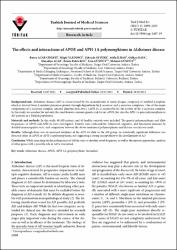| dc.contributor.author | Acar Çinleti, Burcu | |
| dc.contributor.author | Yardımcı, Nilgül | |
| dc.contributor.author | Aytürk, Zübeyde | |
| dc.contributor.author | İlhan, Atilla | |
| dc.contributor.author | Kaya, Gülhan | |
| dc.contributor.author | Acar, Muradiye | |
| dc.contributor.author | Koç, Emine Rabia | |
| dc.contributor.author | Gündüz, Esra | |
| dc.date.accessioned | 2019-10-28T07:37:23Z | |
| dc.date.available | 2019-10-28T07:37:23Z | |
| dc.date.issued | 2015 | en_US |
| dc.identifier.issn | 1300-0144 | |
| dc.identifier.issn | 1303-6165 | |
| dc.identifier.uri | https://doi.org/ 10.3906/sag-1407-19 | |
| dc.identifier.uri | https://hdl.handle.net/20.500.12462/9309 | |
| dc.description | Koç, Emine Rabia (Balikesir Author) | en_US |
| dc.description.abstract | Background/aim: Alzheimer disease (AD) is characterized by the accumulation of senile plaques composed of amyloid beta-peptide, which is derived from beta-amyloid precursor protein through degradation by beta-secretase and.-secretase complexes. One of the major components of gamma-secretase complex, anterior pharynx-defective-1 (APH-1), is responsible for the activity of the.-secretase complex. In this study, we searched for not only the most known common genetic risk factor, APOE, but also the APH-1a gene polymorphism in AD patients in a Turkish population.
Materials and methods: In this study, 49 AD patients and 45 healthy controls were included. The genetic polymorphisms and allele frequencies of APOE and APH-1a were investigated. Patients were evaluated for behavioral, cognitive, and functional domains by detailed neurocognitive tests, and comparison between the above-mentioned polymorphisms and disease severity was made.
Results: Although there was an increased tendency of the APO epsilon 4 allele in the AD group, no statistically significant difference was detected either in APOE or APH-1a polymorphisms, not suggesting a strong susceptibility to the development of AD.
Conclusion: While searching for the pathogenesis of AD in order to develop novel diagnostic as well as therapeutic approaches, analysis of other genes with a possible role in AD is warranted. | en_US |
| dc.description.sponsorship | Turgut Ozal University - 2013-04-002 | en_US |
| dc.language.iso | eng | en_US |
| dc.publisher | Tubitak Scientific & Technical Research Council Turkey | en_US |
| dc.relation.isversionof | 10.3906/sag-1407-19 | en_US |
| dc.rights | info:eu-repo/semantics/openAccess | en_US |
| dc.subject | Alzheimer Disease | en_US |
| dc.subject | Apoe | en_US |
| dc.subject | Aph-1a | en_US |
| dc.subject | Polymorphism | en_US |
| dc.subject | Biomarker | en_US |
| dc.title | The effects and interactions of apoe and aph-1a polymorphisms in alzheimer disease | en_US |
| dc.type | article | en_US |
| dc.relation.journal | Turkish Journal of Medical Sciences | en_US |
| dc.contributor.department | Tıp Fakültesi | en_US |
| dc.identifier.volume | 45 | en_US |
| dc.identifier.issue | 5 | en_US |
| dc.identifier.startpage | 1098 | en_US |
| dc.identifier.endpage | 1105 | en_US |
| dc.relation.publicationcategory | Makale - Uluslararası Hakemli Dergi - Kurum Öğretim Elemanı | en_US |


















